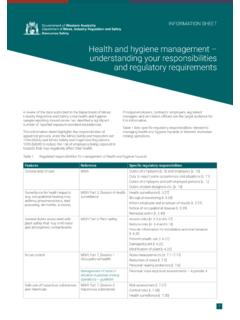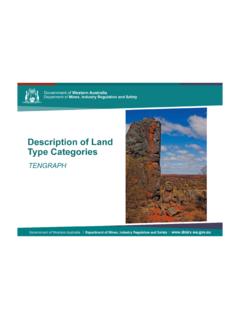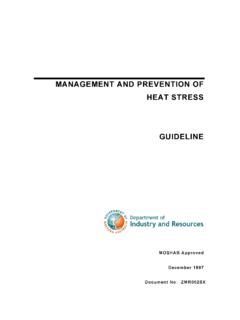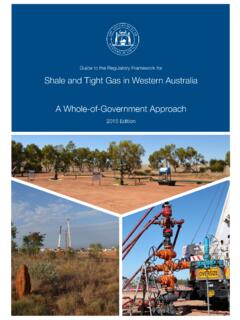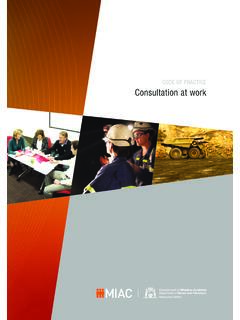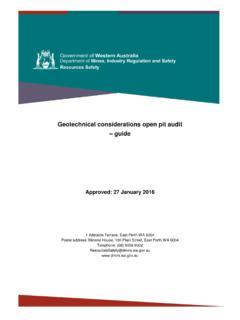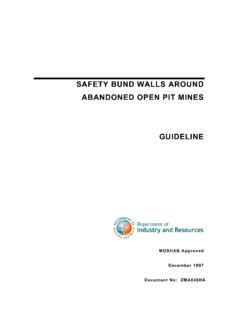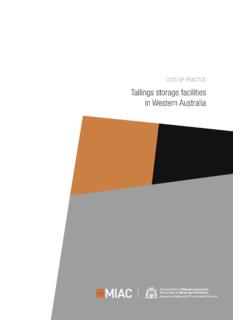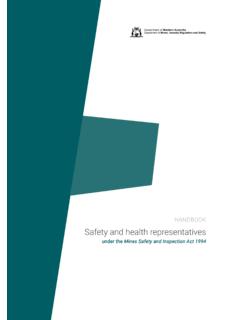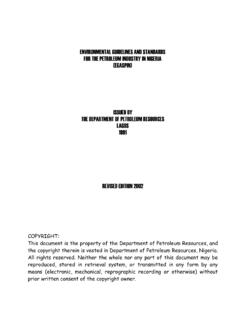Transcription of Acid Mine Drainage
1 Department of Mines and Petroleum, Mineral House, 100 Plain Street East Perth, WA 6004 Tel: +61 8 9222 3333, Fax: +61 8 9222 3862, Email: Web: Acid Mine Drainage Environmental Notes on Mining, updated September 2009 Pyrite (FeS2) is commonly associated with coal and metal ore deposits. Its oxidation occurs spontaneously in nature, causing environmental problems like Acid Mine Drainage (AMD) and mine-tailing leachate containing heavy metals. Discharge of acid Drainage into water bodies causes an instant threat to the biota and ecological balance. In addition, acid Drainage can threaten drinking water supplies and irrigation systems downstream from a mining site. AMD is a specific type of wastewater, which arises in mining of sulphidic ores, ore tailings or overburdens. At sites of moderate-to-high rainfall, AMD can be produced in large quantities, which significantly complicates its treatment.
2 Due to mineralogy, and other environmental factors (especially climate), the potential for AMD formation is highly variable from site to site. Pyrite oxidation takes place when the mineral is exposed to air and water. AMD involves the oxidation of pyrite and other sulphides, and yields Fe3+ and sulphuric acid. The overall chemical reaction governing pyrite oxidation is: FeS2 + 15/4 O2 + 7/2 H2O Fe(OH)3 + 2SO4 2- + 4H+ Note that the oxidation of sulphidic minerals can be accelerated by a special group of bacteria called acidophiles ( Thiobacillus thiooxidans and Thiobacillus ferrooxidans). Both water and oxygen are necessary to generate acid Drainage . Water serves both as a reactant and as a medium for bacteria in the oxidation process. Water also transports oxidation products. Oxygen is required as a reactant and to sustain bacteria. Unsaturated and moist conditions in mine-waste profiles and tailings beds represent near-optimal conditions for sulphide oxidation.
3 Acid Drainage can continue long after mining operations are complete. Abandoned mines can represent a substantial liability for industry and government once the economic resource at a site has been mined out. INVESTIGATION The aim of investigations is to identify the presence of sulphides. If present, define the nature, abundance and distribution of sulphides in order to determine appropriate management strategies. The investigation stages should include the following: Desktop assessment ( geology, hydrology, bore logs) Department of Mines and Petroleum, Mineral House, 100 Plain Street East Perth, WA 6004 Tel: +61 8 9222 3333, Fax: +61 8 9222 3862, Email: Web: Sampling Laboratory analysis Report (including an appropriate management plan) SAMPLING Selection of the samples ( drill core, drill cuttings) has important implications for subsequent testing for potential acid formation.
4 The purpose of testing rock material is to classify the rock material, which in turn facilitates appropriate planning measures for the mine waste. Samples must be selected to characterize both the type and volume of rock materials and also to account for the variability of materials that will be exposed during the life of the mine. It is also important to identify and quantify low sulphidic materials as well as alkaline materials. Plan views and geological cross sections will give a good understanding of the local geology which should be used to show the spatial distribution of samples within the major rock units and major forms of mineral alteration. Mining for sand or mineral sands is more like to follow the Acid Sulfate Soils (ASS) sampling methodology. Department of Environment and Conservation developed a series of guidelines for the assessment and management of ASS. Other factors to consider in a sampling programme include: the method of sample collection; length of time samples have been stored, and storage conditions.
5 Each of these factors can affect the physical and chemical characteristics of the samples. If samples are collected from drill cores, contamination may be a problem if a lubricant was used. Samples collected from cores exposed to the environment may be physically and /or chemically altered. LABORATORY ANALYSIS A geochemical testing programme is generally performed on samples of mine waste to determine the current and potential long-term geochemical characteristics of the waste material. There are a number of procedures to determine the acid forming capacity of mine waste materials. The basic screening tests are: pH; Electrical-Conductivity (EC); Acid-Base Accounting (ABA); Multi-element composition; and Mineralogy Department of Mines and Petroleum, Mineral House, 100 Plain Street East Perth, WA 6004 Tel: +61 8 9222 3333, Fax: +61 8 9222 3862, Email: Web: The ABA evaluates the balance between acid generation processes and acid neutralizing processes.
6 The values arising from the ABA are referred to as the maximum potential acidity (MPA) and acid neutralising capacity (ANC). These methods are called static tests because they represent a single measurement in time. Kinetic tests ( column tests ) attempt to mimic natural oxidation reactions of the field settings. They are used to measure sulphide reactivity and weathering behaviour, including oxidation rate and metal leaching . These tests typically use a larger sample volume and require a much longer time for completion than for static tests . ANALYSIS RESULTS In terms of acid forming capacity, mine waste materials may be classified as: Non-Acid Forming (NAF) Potentially Acid Forming (PAF) There are varying criteria for distinguishing NAF and PAF classifications. For example, PAF classification criteria often used at mining operations include: NAF: ANC/MPA* ratio 2.
7 PAF: ANC/MPA ratio < 2. *MPA: It is calculated from (Total %S) x where MPA (like ANC) is expressed in kg H2SO4/tonne. Material classification must be performed prior to the proposed excavation. This information is required to enable the planning of preventative measures ( selective handling, burial or isolation). In this manner costly long-term mitigation programmes are avoided. MANAGEMENT PLAN There are a great variety of strategies available to prevent or mitigate the impact of AMD. These include avoidance of disturbance, dry covers, underwater storage, neutralization and collection and treatment. Each of these strategies targets a different aspect of AMD, uses different mechanisms or processes and varies in its effectiveness. Avoidance of disturbance of a potential acid forming material is always the preferred option. PAF materials are inert as long as they are not exposed to oxygen and water.
8 If disturbance is inevitable, minimisation of acid Drainage requires control of oxygen diffusion, water infiltration and neutralisation of existing and potential acidity. Department of Mines and Petroleum, Mineral House, 100 Plain Street East Perth, WA 6004 Tel: +61 8 9222 3333, Fax: +61 8 9222 3862, Email: Web: There are basically two types of covers: wet covers and dry covers. The most common type of wet cover is underwater placement. The most common type of dry cover is the impermeable barrier, such as a multi-layer barrier. The climatic setting and topography of the mine-site has a direct bearing on the choice of either wet cover or dry cover for the long-term containment of sulphidic materials. Dry Cover System Implementing a dry cover system is a common AMD prevention and control technique. The objectives of a dry cover system are to minimise the influx of water and provide an oxygen barrier.
9 Apart from these functions, dry covers should be resistant to erosion and should provide support to vegetation. For example, a low permeability layer, typically achieved through compaction of local borrow material, is placed directly on the underlying waste. The objective is to provide a hydraulic barrier to percolation of water. A non-compacted layer must overlay the compacted layer. Its objective is to establish a sustainable vegetation cover and at the same time reduce the net percolation. Additional design objectives for dry cover systems placed on reactive tailings and waste rock, may consider oxygen consumption (organic cover materials) and reaction-inhibiting materials ( limestone). Several factors influence the design objectives of a dry cover system. The key factors are climate conditions, waste material reactivity and type of waste material. Reactive waste will usually indicate that a higher quality cover system is required to control further reactions.
10 Successful long-term cover performance requires pro-active detection and resolution of problems prior to significant environmental impacts. This involves monitoring, maintenance, repair and contingency plans. When considering AMD management, best environmental practice requires site-specific adaptation of local resources and environment conditions. Water Cover Systems An alternative to prevent AMD is to bury PAF material under water. The water will work as an oxygen barrier. The dissolved oxygen concentration in water is at 25 C, which is approximately 25000 times lower than in the air. Organic matter and other reduced compounds can rapidly consume the dissolved oxygen in the water, which is then not available for sulphide oxidation. Concerns to be addressed include the potential delay in attaining full submergence, the potential overtopping of the water-storage structure, water level fluctuations and the eventual loading and discharge locations.
